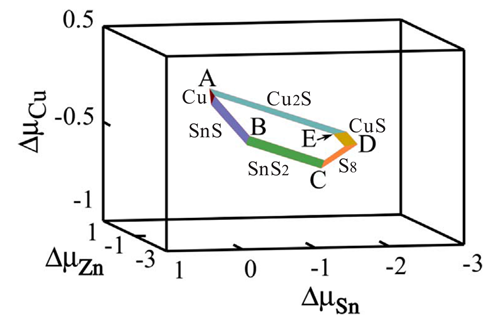Recently, the research group of the Institute of Solid State Physics, Institute of Solid State Physics, Hefei Research Institute of Physics, Chinese Academy of Sciences, Zeng Jun, has made new progress in the research of thin-film solar cell materials. Through simulation calculations, the types of intrinsic defects that impede cell efficiency in Cu2ZnSnS4 (CZTS) have been theoretically screened out and proposed. The relevant results are published online in the magazine Solar Energy Materials and Solar Cells 180, 118-122 (2018).
All the elements that make up the CZTS are abundant and non-toxic in the earth and are recognized as environmentally friendly, low-cost, high-efficiency battery candidate materials. However, the maximum efficiency of current CZTS-based solar cells is about 12.7%, which is much lower than the highest efficiency (20.3%) of its similar compound Cu(In,Ga)Se2. One of the important reasons is that there are many impediments to carrier flow in CZTS. The localized defect of the charge transported by the child. At present, experimental techniques cannot judge the type of defect from the atomic scale. Theoretically, the type of the main charge localized defect can be accurately determined by studying the formation energy of the defect and the charge transfer energy level.
Based on the study of the hybrid functional theory, Zeng Zhao's group found that CuSn and CuZn are the main charge localized defects in CZTS, and their influence on carriers is not the same. CuSn forms a deep impurity level in the band gap through which electron-hole pairs recombine, so CuSn is a deep level recombination center. The position of CuZn impurity is relatively low, and ionization and contribution of carriers are easy. However, the ionized CuZn-type tends to form an acceptor-donor defect pair with ZnCu+ compensation. The CuZn- and CuCu+ ions of opposite polarity attract each other. The material introduces large potential fluctuations that can trap carriers, thus reducing the carrier concentration in the material. Moreover, through further research, the research group proposed a method to suppress these two kinds of localized defects: (1) The Sn-rich growth environment suppresses CuSn, because the chemical formula of Sn in CZTS has a very large range of changes, and by creating a Sn-rich growth environment, Can inhibit CuSn; (2) Cd doping inhibits CuZn, because the doped Cd will occupy the position of Zn and reduce the possibility of CuZn formation. Both programs have been experimentally supported.
The above work was supported by the national "973" project and the National Natural Science Foundation of China. The calculations were completed at the Hefei Branch of the Supercomputing Center of the Chinese Academy of Sciences.

Figure 1. The formation energy of different charge localization defects at different points of the chemical potential stability interval as a function of the Fermi level. The formation energy less than 1.5 eV is mainly CuZn and CuSn.

Figure 2. CZTS chemical potential stability interval, the area surrounded by polygons.

Figure 3. The formation energy of impurities introduced by Cd doping varies with the (a) Fermi level (b) chemical potential. The lowest formation energy of CdZn indicates that the Cd impurity tends to occupy the position of Zn and suppress the formation of CuZn.
PP Woven Bag also named Woven Cloth, We professional produce PP bag with 100% virgin polypropylene material,high strength.
PP woven bag are extensively used in the construction of irrigation works, roads, railways, ports, mines, buildings, and more. Having the functions of filtering, draining, isolation and anti-seepage.
Our Plastic Woven Bag export to Malaysia,Singapore,Latvia,American,,Chile,Argentina etc countries.
PP Woven Bag
PP Woven Bag,White PP Woven Bag,PP Woven Fabric,PP Woven Sand Bag
HEBEI TUOHUA METAL PRODUCTS CO.,LTD , https://www.penettings.com